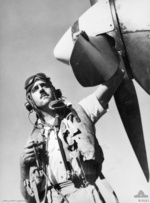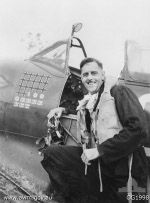Clive Caldwell
| Surname | Caldwell |
| Given Name | Clive |
| Born | 28 Jul 1911 |
| Died | 5 Aug 1994 |
| Country | Australia, United Kingdom |
| Category | Military-Air |
| Gender | Male |
Contributor: Morgan Bell
ww2dbaseOf all the births in Australia's most populous city, Sydney, during 1911, Clive Robertson Caldwell's birth might have seemed the least auspicious. Yet he was destined to become Australia's top scoring ace pilot, accumulating 28.5 kills over the course of the war, earning him the nickname "Killer" among his comrades. On a list of British and Commonwealth aces during the Second World War, Caldwell's name can be found in tenth place. He is among the ranks of a little over a thousand Allied aces who fought in the Second World War, contributing to the RAF's campaign in Europe and North Africa, and the RAAF's defence of Australia against the Japanese.
ww2dbaseHad fate not intervened with a challenge to test the mettle of the Australian nation, and an opportunity to train a champion of the skies, Clive Caldwell might have led the very mundane existence of a trainee clerk at the Bank of New South Wales, a job his father had pushed Caldwell into when he left school. Caldwell's fascination with piloting aeroplanes began in 1938, when he joined the Royal Aero Club of New South Wales, by the time Australia joined the Second World War on the mother country's side, he had only logged eleven hours solo flying time in an antiquated, First World War era Tiger Moth. At the age of 29, Caldwell signed up for the Empire Air Training Scheme, which gave young dominion pilots experience in the war in the Western theatre, a plan hoping to alleviate Britain's lack of operational pilots. Through it, Australia contributed 27,000 air crew to operations in Britain's war against Germany. Caldwell was dispatched to the Middle East, like many young Australians, eager to fight alongside Britain, upon arrival Caldwell was assigned to No. 250 Squadron RAF, flying Tomahawks. It was in this assignment that Caldwell tasted the exhilaration of his first victory over the enemy, a German Messerschmitt BF-109, after this his score steadily rose. When he had attained a tally of eighteen enemy aircraft, he was transferred to No. 112 Squadron RAF as squadron commander. This squadron piloted Kittyhawks, but later converted to a fighter/bomber role, before the conversion was complete, the Japanese were looming over Australia as an ominous threat, his own nation would need as many experienced pilots as it could obtain. By the time Caldwell left for Australia, he had 550 hours operational flying time, and twenty and a half kills.
ww2dbaseThe return to his homeland drew nigh; Caldwell had fought alongside pilots of many different nationalities during his tenure with the RAF. Many pilots from Poland were among their number. Having served with so many Polish pilots, on 2 August 1942 Caldwell was honoured with the Polish Cross of Valour. Upon return to Australia he was made Wing Leader of the No. 1 Fighter Wing, flying their Spitfires to the aid of Darwin, which was attempting an outmatched defence against a Japanese air raid. In Australia, Caldwell's talents as a fighter ace did not produce appreciation in the upper ranks of the RAAF as they had in his involvement in previous operations in the European theater. Of Caldwell, Vice Marshal Sir George Jones wrote "This officer is an Empire Air Trainee which is considered already sufficiently decorated and is to receive no more regardless of further service". After such a welcome home, in an under-resourced, as well as apathetic, RAAF, many Empire Air Training Scheme trainees were resentful of their country's treatment of their patriotic service through dangerous exploits. Caldwell was made Chief Flying Instructor of a training unit.
ww2dbaseThe conduct of the conflict in the Pacific was like a different war entirely to the one fought in Europe. It revealed a rift between the pilots risking their lives to coax their heavier than air machines into the sky to strike a blow against Japan, and the men of high rank who sat safely behind their desks in the Defence Department in Melbourne. Since the Americans had taken a larger role in the air war in the SWPA, RAAF pilots were assigned less important, more dangerous tasks. In May 1944, Caldwell returned to operational posting, when he was appointed as wing commander of No. 80 Fighter Wing, which was assigned to a ground attack rather than a fighter role. On the airfield on the island of Morotai in the Netherlands East Indies, Caldwell and two other operational RAAF officers handed in their resignations in protest, in what became known as the Morotai Mutiny, but all officers were later reinstated. Caldwell finally resigned from the RAAF on 5 March 1946.
ww2dbaseSources: J. Watson, Killer Caldwell: Australia’s Greatest Fighter Pilot, Australian War Memorial, J. Beaumont, Australia's War: 1939-45.
Last Major Revision: Aug 2008
Clive Caldwell Interactive Map
Photographs
 |  |
Clive Caldwell Timeline
| 28 Jul 1911 | Clive Caldwell was born. |
| 5 Dec 1941 | Australian pilot Clive Caldwell, in a Tomahawk fighter, shot down five Stuka dive bombers in Libya. |
| 14 Dec 1941 | German pilot Oberfeldwebel Hermann Förster was strafed by a British fighter while he was descending in a parachute. Some thought the British pilot might had been Clive Caldwell. |
| 24 Dec 1941 | Clive Caldwell damaged the German Bf 109 fighter piloted by Oberleutnant Erbo von Kageneck over Agedabia, Libya. Kageneck would die of the wounds sustained in this engagement in a military hospital in Naples, Italy on 12 Jan 1942. |
| 10 Mar 1942 | Clive Caldwell of No. 112 Squadron RAAF made the first 250-pound bomb drop from a Kittybomber. |
| 5 Aug 1994 | Clive Caldwell passed away. |
Did you enjoy this article or find this article helpful? If so, please consider supporting us on Patreon. Even $1 per month will go a long way! Thank you. Share this article with your friends: Stay updated with WW2DB: |
Visitor Submitted Comments
5 Feb 2013 08:51:42 PM
Without doubt,Clive Calwell is a real inspiration to me as a very brave,talented
pilot who is admired by many Australians and
also the British.His integrity is without
question ...a leader amongst men ..the best of the best....I salute you.
5 Feb 2013 09:04:05 PM
The top scoring Australian pilot of WW2..and how many Australians have heard about him and his exploits.We Australians should have more info about these brave Australians on an Aust website..after all they helped save
Australia.
27 Feb 2017 07:12:10 PM
Clive Caldwell is discussed on
ABC OPEN MARCUS HILL
28 Jul 2019 04:33:34 AM
War is a bitch but hero's like Caldwell are very rare because not only was he an excellent pilot he could actually use his guns to great effect.
6 Aug 2019 04:48:10 AM
Clive Caldwell was a true Aussie Hero and the younger generation should read his life storey.
All visitor submitted comments are opinions of those making the submissions and do not reflect views of WW2DB.
- » Wreck of USS Edsall Found (14 Nov 2024)
- » Autumn 2024 Fundraiser (7 Nov 2024)
- » Nobel Peace Prize for the Atomic Bomb Survivors Organization (11 Oct 2024)
- » Wreck of USS Stewart/DD-224 Found (2 Oct 2024)
- » See all news
- » 1,150 biographies
- » 337 events
- » 43,917 timeline entries
- » 1,241 ships
- » 350 aircraft models
- » 207 vehicle models
- » 374 weapon models
- » 123 historical documents
- » 260 facilities
- » 470 book reviews
- » 28,541 photos
- » 432 maps
Fleet Admiral Chester W. Nimitz, 16 Mar 1945
Please consider supporting us on Patreon. Even $1 a month will go a long way. Thank you!
Or, please support us by purchasing some WW2DB merchandise at TeeSpring, Thank you!
12 Nov 2012 05:25:45 PM
Awesome info, did he have a younger brother or sister?